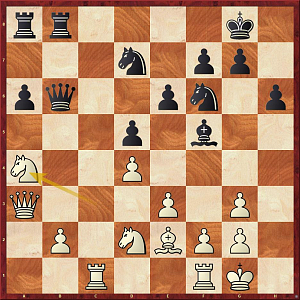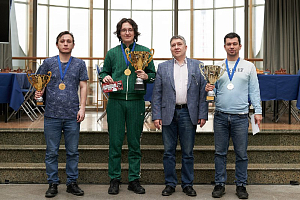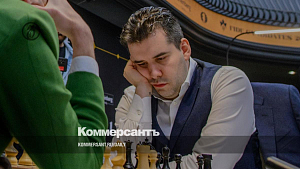9 May 2015
Warm-up Before the Waterloo
Day 4 of the Russian Club Championship by Dmitry Kryakvin and Vladimir Barsky.
Right from the start I would like to complain to my dear reader about lack of luck. My valuable colleague Sergey Juryevich will be better off telling you in the upcoming review everything about the magic battle between the ice-cold "Siberia" and the hot southern "University". However, the round that came his less fortunate colleague’s way is where the three matches feature the favourites neatly "outclassing" their opponents to gain their two match points, whereas the detailed consideration is deserved only by a brilliant victory of Siberians over the Moscowites. After all, each team there in Sochi slaves away without time off intervals for weekends because the price of each game is extremely high. If you fail to qualify into the European Cup your sponsor will deny you any further financing. Or otherwise you return home without a medal. So, let us not demand that players draw abundant blood because the tournament is very interesting just the way it runs.
So, the co-leaders from Belorechensk have defeated “Zhiguli” with a 4-2 score. It can’t be said that the grandmasters from “University” have been pressing a great deal, it’ rather that two points have literally fallen into their hands.
Frolyanov (“Zhiguli”) – Rublevsky (“University”)
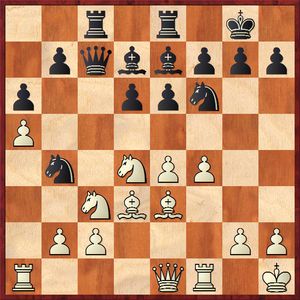
A very well-known position from the Scheveningen variation, which in dozens of encounters, beginning with the game Psakhis – Kasparov played in 1992, featured a drawish continuation 15.Qg3 Nh5 16.Qf3 Nf6 17.Qg3 Nh5 with repetition of moves. Dmitry was already on the point of rubbing the squares g3 and f3 with his queen when, perhaps, he felt the pangs of conscience for losing the advantage of the first player, or else someone of Frolyanov’s teammates endowed him a warm glance, devoid of ill-disposition. There followed an unexpected 18.Qh3 Nf6 19.Nf3?! e5 20.f5 d5 21.exd5 Nbxd5 22.Nxd5 Nxd5 23.Bg5? h6 24.Bd2 Bf6 25.Rae1 Nf4 26.Qg3 Nxd3 27.cxd3 Bxf5, when White has ended up with a pretty much resignable position.
Aleksandrov (“University”) – Geller (“Zhiguli”)
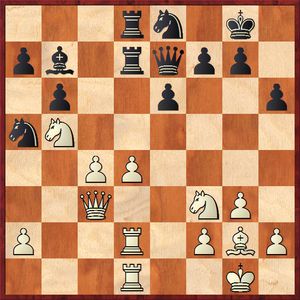
Jakov Geller, recognized for his fundamental knowledge of the chess openings, has masterfully handled the initial part of the game and, in case of a simple 25 ... Nf6, the grandmaster from Belarus would have had to summon all his chess workmanship and understanding so as not to end up in a worse position. There followed, however…
25... Bxf3? 26.Bxf3 Nd6 27.Nxd6 Qxd6?
Not so deadly would have been to choose 27...Rxd6 28.c5 Qc7 29.Rc1 R6d7 (dangerous is the straightforward continuation 29...bxc5 30.Qxc5 Qb6 31.Qa3! Rxd4 32.Rb2 Ra4 33.Qe7 Qxb2 34.Qxd8+ Kh7 35.Rc8 with mating threats). This way in case of 30.c6 Rd6 the threat of the d4-d5 advance is out of the agenda, but with the black knight still on а5 his position is quite unpleasant anyway.
28.c5 Qc7 29.c6 Rd6 30.d5!
And it turns out that after 30...exd5 31.Rxd5 Rxd5 32.Rxd5 Rxd5 33.Bxd5 Black may well as resign here. Jakov preferred 30…e5, but there was no stopping Aleksandrov any longer.
31.Be4 g6 32.a4 Re8 33.Re1 Nb7 34.Bc2! Rdd8 35.Qe3 Nd6 36.Qxh6, and very soon White got the upper hand.
I would like to say only the kindest words about the team from Yamal. Once the line-up of the Premier League teams was published I heard a lot of comments like, “Do they realize what they are up against? How many personal wins are they going to collect in the final run anyway?” Nevertheless, the non-stellar team from Salekhard has put up a vigorous resistance and, if not for the match with “sinister” Petersburgers, they looked more than fine in their matches against Kazan, Moscow and Ekaterinburg teams. Although “Malakhit” defeated “Yamal” with a 4:2 score, it should be noted that all those who lost their games had at certain moments definitely missed sure winning continuations.
Belyakov (“Yamal”) – Shirov (“Malakhit”)
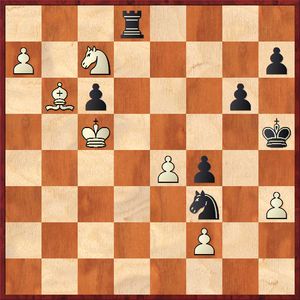
Bogdan has completely outperformed his famous opponent and could have won even earlier, if not for Shirov’s resourceful resorting to complications in a time trouble. Now he had to follow the only path to a win, but not a difficult one to find.
47.a8Q?
Why do it if you can still promote your pawn to a queen via simple manoeuvring? After 47.Kxc6 Kh4 48.Kb7! Kxh3 49.Ne6 Black had no opportunity to sacrifice his rook for a passed pawn due to interference on the d8-square and his resignation would be inevitable.
47...Rxa8 48.Nxa8 Kh4 49.Kd6 Kxh3 50.e5 Kg4 51.e6 Nh4!
This sideward lunge of the knight saves Black. In case of 52.e7 Nf5+ 53.Kd7 Nxe7 54.Kxe7 h5 the passed pawn speeds along the edge of the board towards the queening square, therefore Belyakov made up his mind to seal a draw.
52.Nc7 h5 53.Ke5 Nf5 54.Ne8 h4 55.Nf6+ Kf3 56.Nh7 Kg4 57.Nf6+ Draw.
Grischuk has easily prevailed over Potapov the-junior, while the final period in the match was effectively put by Denis Khismatullin.
Khismatullin (“Malakhit”) – Savitskiy (“Yamal”)
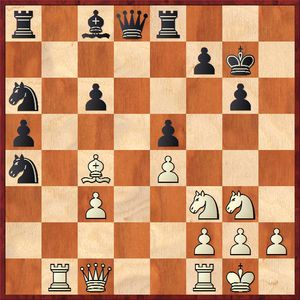
Black has a remote passed pawn, if only they had a couple of additional tempi to consolidate the position…However, the dark cavalry is stuck on the edge of the board and Khismatullin capitalizes on this disadvantage in a very convincing manner.
23.Bxf7! Kxf7 24.Qh6 Qf6
In case of 24...Re7 25.Rfd1 Qf8 26.Nxe5+ Rxe5 27.Qf4+ White wins back material and goes on to retain the crushing attack.
25.Ng5+ Ke7 26.f4 Rh8
The king cannot escape in view of: 26...Kd8 27.fxe5 Qe7 28.Rbd1+ Kc7 29.Rf7.
27.Nh7 exf4
Not good is 27...Qf7 28.Qg5+, the following continuation is quite effective-looking 27...Nxc3 28.f5 Nxb1 29.fxg6 Qxf1+ 30.Kxf1 Be6 31.g7 when the queen together with knights and a passed pawn prevails over multiple enemy pieces. What happened in the game was more mundane than that.
28.e5 Qe6
28...Qxe5 loses the queen in view of 29.Rbe1.
29.Qg7+ Qf7 30.Qxh8 Nxc3 31.e6 Black resigned.
The team from Kazan succumbed to "Bronze Horseman" in a viscous battle similar in the nature to the first two matches spoken about previously.
The first four boards drew their games, but on board sixth Saric elegantly converted his advantage in a rook ending against Sharafiev. But prior to that, “Zenit” had scored a much less deserved goal against "Rubin".
Khairullin (“Bronze Horseman”) – Makhmutov (“Rook”)
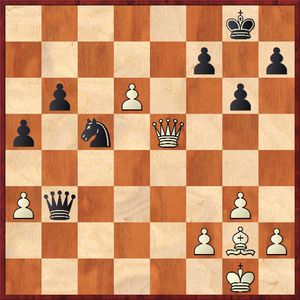
37...Qe6?
Rail was short on time and opted for a tempting queen move that failed him in the final run.
Black had two alternatives at his disposal. One was a failure as after 37...Ne6? 38.Bd5 Qd1+ 39.Kg2 Nf4+ 40.gxf4 Qg4+ 41.Kf1 Qd1+ 42.Qe1 Qxd5 43.Qe8+ Kg7 44.Qe5+! Qxe5 45.fxe5 Kf8 46.a4, White wins in the arising pawn ending.
Black should have forced the white bishop into a misplaced position by 37...Qd1+! 38.Bf1 Ne6 39.Kg2 Qa4, when the threat to the а3-pawn does not allow White to successfully regroup his forces.
38.Qd4 Qd7 39.h4 h5 40.Kh2!
This is the point! The light-squared bishop joins the assault from h3 and Black can no longer hold his position together.
40…Kh7 41.Bh3 Qd8
41...Qe8 42.Qf6 does not change much.
42.Qe5 Qf8 43.Qe7 Kg7 44.Qc7, and Makhmutov stopped the clock.
The encounter between "Siberia" and "ShSM-Our Heritage" was the main intrigue of the round. I can honestly say that I feel very sorry for the Moscowites. Once SHSM-64 was the country’s club movement leader; however, the duty of the spearhead of the country's two-time champion has always been imposed on an invited elite grandmaster, whereas the flanks have been secured by swift and ruthless Chinese players. Nowadays the ShSM is a purely Moscow team that venerates the glorious traditions of, say, "The Petrosian Club" of the Soviet period. It is very honest in itself, but since the moment Moscowites agreed to stick to this formula, they have been constantly haunted by failures. Once they were not lucky with the drawing of lots, the other time they suffered a bitter defeat in a key match. Now the supervisees of Smagin found themselves in the firing line of the Siberian Titans, and their struggle has been further aggravated not only in terms of medals, but even in terms of the European Cup qualification.
Kramnik (“Siberia”) – Nepomniachtchi ("ShSM-Our Heritage")
Queen’s Pawns Game A48
1.d4 Nf6 2.Nf3 g6 3.Bg5
What a surprise! Kramnik has played like this three times in his life in the blitz games. An intriguing point is that according to the official theory Black can easily equalize by carrying out the timely e7-e5 advance... Has Vladimir Borisovich showed up well prepared, or was he just counting on the fighting spirit of Ian Alexandrovich? However, this tough line remained unplayed in this game.
3…Bg7 4.Nbd2 0–0 5.e3
This is considered more flexible as in case of 5.c3 Black can respond with 5…d5 6.e3 Nbd7 7.Bd3 Re8 8.0–0 e5. If White wants to adopt a more principled approach rather than simply end up competing in an equal position, then 9.e4!? h6! (very interesting is 9...exd4!? 10.cxd4 dxe4 11.Nxe4 h6 12.Qb3! Re7 13.Ne5 hxg5 14.Nxf7 Nc5! 15.Nxf6+ Bxf6 16.dxc5 Rxf7 17.Bxg6 Qf8 18.f4 g4 19.f5 Bd7 20.Rf4 Bc6, as was in the game between Yusupov and Shirov, but does Black really want such complications?) 10.Bxf6 Bxf6 11.exd5 exd4 12.Nxd4 Nb6, and Black equalizes, a special thanks for which belongs to Andrei Volokitin.
5...d6
Ian once employed 5...d5 to outperform Sasikiran. Of course, besides 6.Bd3 White can choose 6.Be2 or a Petrosian-styled continuation 6.c3 Nbd7 7.Be2 Re8 8.b4 e5 9.0–0 c6 10.Nb3, but objectively speaking Black’s position is OK. Well, either both opponents knew something that we, ordinary mortals, do not fathom, or else Ian believed that the situation on the rest of the match boards might not be an easy one and, therefore, that he should maintain tension in his game with the former World Champion.
Here is, by the way, a display of Kramnik’s performance from one of his blitz games: 6.Bd3 c5 7.c3 b6 8.0–0 Ba6 9.Bxa6 Nxa6 10.Qe2 Nc7 11.Rad1 cxd4 12.Nxd4 e5 13.N4f3 h6 14.Bh4, and here in the 2007 game Ruslan Ponomariov blundered a pawn via 14…Qd7 15.Nc4.
6.c3 Nbd7 7.Bd3 e5 8.0–0 h6 9.Bh4 Qe8
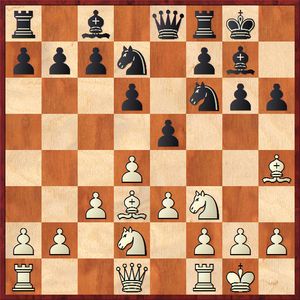
10.e4
In case of 10.Qc2 a good response would be 10…Nh5, therefore the bishop’s position on d3 needs to be secured.
10...b6
Ian declines the time-proven 10...Nh5 11.Re1 Nf4 12.Bf1, but at the end it transforms into a typical position just the same.
11.Re1 Bb7 12.a4 a5
Usually Black adopts the “hedgehog” pawn formation with 12...a6, which, on the other hand, is connected with the potential risk of receiving the а4-а5 and с3-с4 advances at some moment to undermine Black’s pawn structure. Nepomniachtchi allows white bishop to comfortably land on b5 but deprives his opponent of the above-mentioned ideas.
13.Bb5 Qc8 14.dxe5
The computer votes in favour or 14.Qc2 c6 15.Bf1 Qc7 16.Nc4 b5 17.axb5 cxb5 18.Na3!? b4 19.Nb5, which is not so clear from the human point of view. Kramnik is true to the classic style of play as he trades pawns in the centre and activates his dark-squared bishop.
14...Nxe5 15.Nxe5 dxe5 16.f3 Rd8 17.Qc2 Qe6 18.Bf2
At some moment of the game the leader of the "Siberia" team has switched over from the gentleman's set of moves, in a good sense of this word combination, to undisguised actions of hooligan nature. So, if you imagine the position on the board after the alleged sequence of moves 18.Nf1 Bf8 19.Ne3 Bc5 20.Kh1 Bxe3 21.Rxe3 g5 22.Bf2, the draw seems to be the most logical outcome. So Kramnik decides to sow a whirlwind on the chess board.
18...Nh5 19.b4 Bf8
The Muscowite is also exhibiting his aggressive spirit, or otherwise he could have just limited himself to a positionally justified 19...Nf4 20.bxa5 Rxa5 21.Nb3 Raa8 22.a5 Ba6!
20.Reb1 Nf4 21.Bf1 Ba6 22.b5 Bb7 23.c4
This is an interesting move that involves the exchange sacrifice. However, this is a sound positional idea. In case of 23.Nc4 Qf6 24.Ne3 h5 Black has an easy game, whereas from now on the opponents need to commit themselves to important positional decisions.
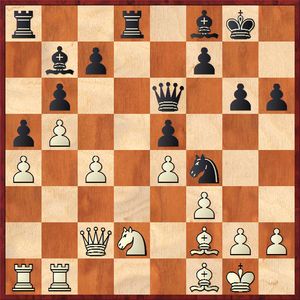
23...Bb4
Just like in the game of poker, Black proposes White to lay the cards on the table to check whose combination is superior. Were the leader of black pieces worried about attaining equality he would have opted for 23...Qf6 24.Nb3 (the exchange sacrifice is not so attractive with a lost tempo as in case of 24.Kh1 Bb4, whereas 24.c5? is just bad due to 24…Nh3+ 25.gxh3 Qg5+) 24...c5! 25.bxc6 Qxc6 26.c5 Ba6.
24.Rxb4!
Of course 24.Nb3 c5 25.bxc6 Qxc6 does not look great as there is no follow-up with 26.c5? due to 26…bxc5 27.Nxc5 Ne6.
24...axb4 25.c5
This is the critical moment! Black should have immediately started his counterplay against the opponent’s king via 25...g5! 26.Nc4 (or 26.cxb6 cxb6 27.Nc4 Rdc8 28.Qb3 g4) 26...bxc5 27.Bxc5 g4, thus distracting white forces from clamping Black on the queenside. In case of further uneventful development the powerful bishop and the remote passed pawn will overpower the rook. Instead, Nepomniachtchi plans to activate his minor pieces, but this strategy is not without a flaw.
25...Qf6?! 26.Nc4 bxc5 27.Bxc5 Ne6 28.Bxb4 Nd4 29.Qc3 Bc8
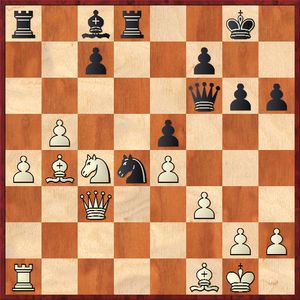
Yet another move and the black bishop is going to occupy an excellent e6-square, but, as it turns out, White can prevent this from happening.
30.Ba5! Qe7 31.Kh1 Bb7
As it often happens in such situations, the preparatory work of one of the opponents is cancelled by a single tactical nuance: not possible is 31 ... Be6 32.Nxe5! Rxa5 33.Qxa5 Nb3 34.Qc3 Nxa1 35.Nc6 and White is winning. Black reluctantly moves his bishop back, which means he is not doing great any longer.
32.Bb4 Qe6 33.Na5 Qb6 34.Nc4 Qe6 35.Na5 Qb6 36.Rc1
White is at deliberate no-hurry as neither opponent’s rooks nor bishop can be moved anywhere, thus providing all the necessary time to strengthen the position by quiet maneuvering.
36…Rd7 37.h3 Kh7 38.Nc4 Qe6 39.a5 Rb8
Yet another time in this game we encounter a tactical peculiarity as the pawn cannot be taken in view of 39...Nxb5 40.Qxe5 Nd4 41.Bc3.
40.Ne3 h5 41.a6 Ba8 42.Qc5 Qb3 43.Bc3 Qe6 44.Bc4 Qf6
The trade of queens does not bring Black any relief as after 44...Qd6 45.Qxd6 Rxd6 46.Bb4 Rd7 47.a7 Rbd8 48.Bc5 White is supposed to bring his advantage home.
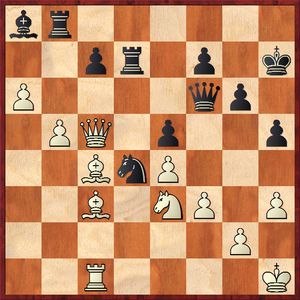
45.Bxd4! exd4 46.Nd5 Qh8
This is a grim necessity as in case of 46...Qe5 47.f4 Black queen is still forced to withdraw to the same square. Kramnik just needs to score a goal with no more than a slight but precise kick at the ball.
47.Rd1 d3 48.Rxd3 Qa1+ 49.Qg1 Qxg1+ 50.Kxg1 Kg7 51.Ra3 f5 52.a7 Rb7 53.Ra6 fxe4 54.fxe4 Rf7 55.e5 c6 56.Nb6 Rfe7 57.bxc6 Rxa7 58.Nxa8 Black resigned. This is yet another masterpiece by Vladimir Kramnik. Except for the 25th move of Black, it is very difficult to say where his younger opponent committed any particular error.
An opening experiment of Vadim Zvjaginsev was confidently taken care of by Dmitry Jakovenko.
Jakovenko (“Siberia”) – Zvjaginsev (“ShSM Our Inheritance”)
French Defence C11
1.e4 e6 2.d4 d5 3.Nc3 Nf6 4.e5 Nfd7 5.f4 c5 6.Nf3 Be7
This sequence of moves when Black delays his usual queenside knight development with 6...Nc6 7.Be3 Be7 has gained a lot of popularity lately.
7.Be3 0–0
More popular is 7 ... b6, without giving White any possibilities to clarify the situation in the centre, but this line has its fans and experts as well.
8.dxc5 Nxc5 9.Qd2 Nbd7?!
Dmitry had this position in the 2012 Russian Cup Final against Igor Lysyj: 9...Nc6 10.0–0–0 Qc7 11.Kb1 a6 12.Qf2 b6, and the game finally ended in a draw. I have difficulty in giving an objective evaluation of this line, but since it was employed by no less than Lysyj it probably means that Black has counter chances. Zvjaginsev decides to activate his knight via another route.
10.0–0–0 b6 11.h4 Bb7 12.Kb1 a6
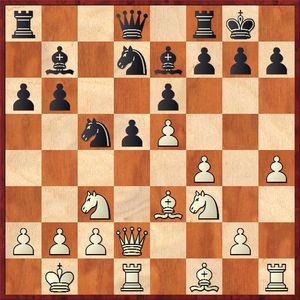
Should White make a couple of soft moves and Black will launch a violent attack after b5 and Nb6-c4 or otherwise open up the diagonal for his b7 bishop. Therefore, it is necessary to hurry. Not bad is 13.f5!? exf5 14.Nxd5 b5 15.Be2, but Jakovenko came up with an almost mathematical solution.
13.Ng5! b5
13...h6 14.Bd3 hxg5 allows White to demonstrate a typical mating mechanism as follows: 15.hxg5 g6 16.Qe1 Kg7 17.Rh7+! Kxh7 18.Qh4+ Kg7 19.Qh6+ Kg8 20.Rh1.
14.Bd3 h6
After 14...g6 15.h5 a direct assault on the black king’s position is launched.
15.b4! Na4
White queen is not to be pushed around as in the following lines: 15...Nxd3 16.Qxd3 hxg5 (16...g6 17.Nxe6) 17.hxg5 f5 (17...g6 18.Bb6! Qxb6 19.Qh3 with inevitable mate) 18.gxf6 Nxf6 19.exf6 Bxf6 20.Qh7+ Kf7 21.Qh5+ Kg8 22.Ne4. However, now White has a possibility to regroup his battery with a tempo.
16.Nxa4 bxa4 17.Bh7+ Kh8 18.Qd3
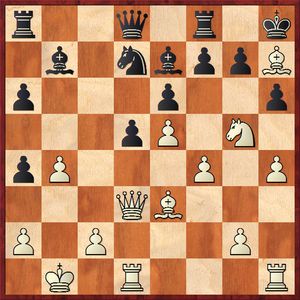
18...Bxg5
Black is up against a rather regrettable choice. 18...Bxb4 is answered with a subtle 19.a3!, and the black bishop lacks the retreat square: 19…Be7 20.Bg8 f5 21.Bxe6, 19...Bc5 20.Bg8 f5 21.exf6 Nxf6 22.Bxc5 or 19...Ba5 20.Bg6 f6 (20...fxg6 21.Qxg6 hxg5 22.hxg5+ Kg8 23.Rh7) 21.Nxe6 Qe7 22.Nxf8 and the game is over in all variations.
18...Qe8 19.Bg8! g6 20.Bxf7 Rxf7 21.Qxg6 Bxg5 22.hxg5 Rh7 23.Qxe8+ Rxe8 24.g6 Rhe7 25.Rxh6+ Kg7 26.Rdh1 d4 27.f5! exf5 28.Rh7+ Kg8 29.Bxd4 does not bring any relief either as the resulting ending is lost for Black.
19.hxg5 a5 20.b5 Qe7 21.Bd4 Rfc8 22.c3!
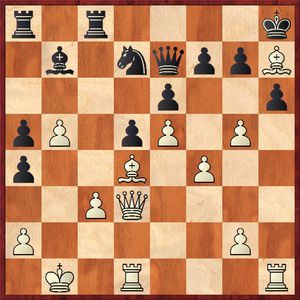
And again, just like in the game of Kramnik, the first player: а) displays an excellent performance, b) can play at his leisure c) it is not possible to find out where his opponent committed an error. It turns out that 22...Nf8 is met with a crushing 23.Bf5!! exf5 24.e6!
Vadim undertakes desperate measures to organize counterplay on the queenside, but succeeds in no more than finding himself in a lost ending.
22...Rab8 23.Ka1 Nc5 24.Qc2 Nb3+ 25.axb3 Qa3+ 26.Qa2 Qxa2+ 27.Kxa2 axb3+ 28.Kb2 Kxh7 29.Ra1 Ra8 30.Ra4 Kg6 31.gxh6 Rh8 32.Rha1 gxh6 33.g4!
This is the final touch, whereas in case of 33.Rxa5 Rxa5 34.Rxa5 Kf5 35.Ra7 Rb8 36.Kxb3 Kxf4 37.b6 h5 White has to think about the protection of the g2-pawn.
33...h5 34.gxh5+ Rxh5 35.Rxa5 Rb8 36.Rg1+ Kf5 37.Rg7
And following the blank shot 37…Ba6? 38.bxa6 Rh2+ 39.Kb1 Black resigned as the check of the black rook on h1 can be intercepted on g1.
A duel between Dubov and Kokarev put an end to sufferings of Muscowites.
Dubov (“ShSM Our Inheritance”) – Kokarev (“Siberia”)
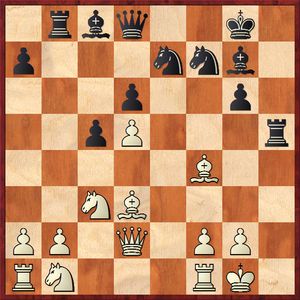
Both opponents performed very creatively in the opening part of the game. Daniil, however, has somewhat forgotten about the b1-knight, which rebounded on him in the final run…
19... Nf5!
The threat of queen lunging to h4 is in the air.
20.Bxf5 Bxf5 21.Bg3 Rb4! 22.Re1 Rbh4 23.f3 Ne5, and the fact that the game lasted up to the 60th move can be attributed only to White’s stubborn defence and some anxiety experienced by his opponent.
In the women's tournament the lead was seized by the team of St. Petersburg, which defeated "University" with a 3-1 score. The fourth game in a row was won by Bodnaruk Anastasia - Nastya knows how to play chess, and in addition to that her task was further alleviated by her opponent.
Pustovoitova (“University”) – Bodnaruk (SDYUSSHOR Hilti)
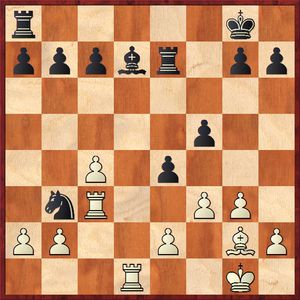
Capturing the knight with the pawn is self-suggesting, there followed, however, 20.Rхb3?? Ba4!, and the scale tilted in favor of SDYUSSHOR (The Specialized Children and Youth Sports School of the Olympic Reserve).
An encounter between two Moscow teams was yet another one of central matches. "Our Inheritance" took the lead after the win of Gunina over Bivol, but "Boavista" succeeded in coming back after Drozdova’s subtle handling of the Modern Benoni against Kashlinskaya. The fate of the match was settled in the duel between Girya and Vasilevich - Olga won two pawns, but in time trouble Irina managed to complicate the game in a sophisticated manner and the fight went on with any outcome becoming possible. With the final 2- 2 score both teams continue to contend the medals. The “Ugra” team narrowed the gap with the leading group upon defeating the "Glek Academy" with a zero score.
So, take your popcorn and enjoy the encounter between “Siberia” and “University” since the hockey match Russia-Canada is not going to happen in the near future, if ever, while such spectacular display of team fight may not be seen this year again!













